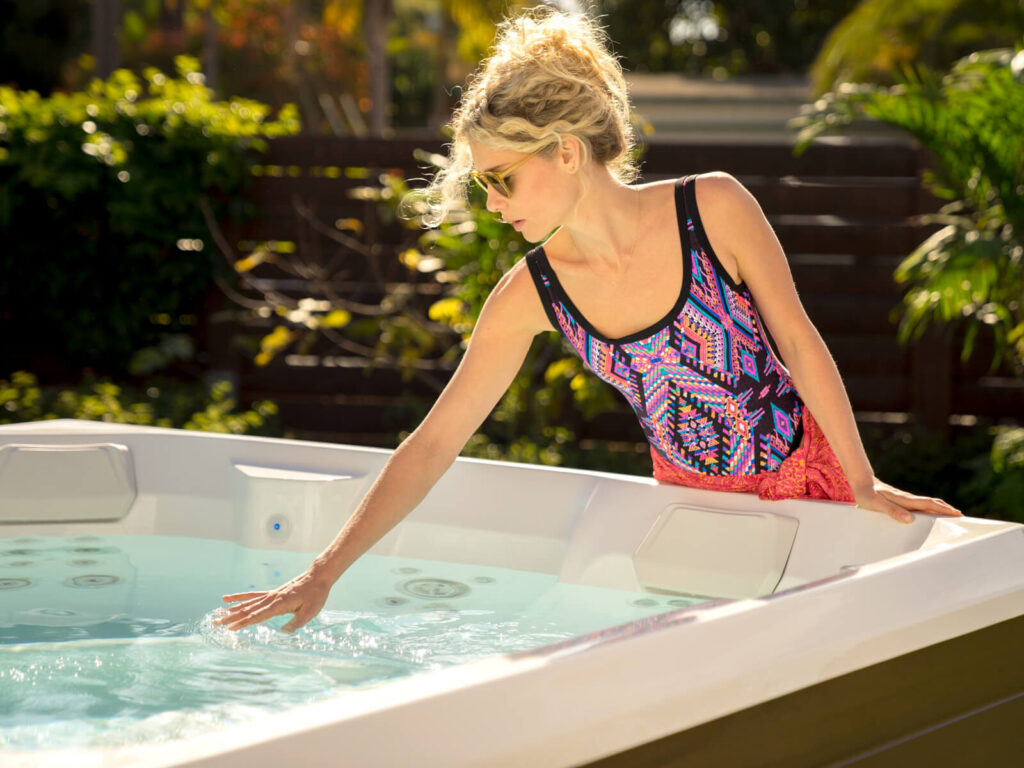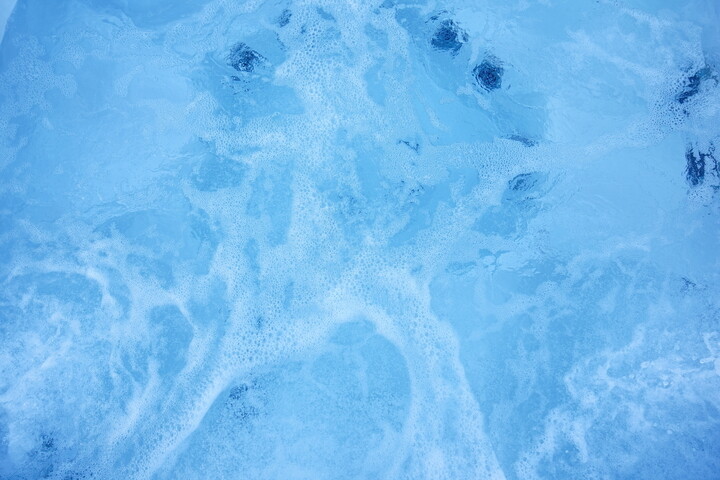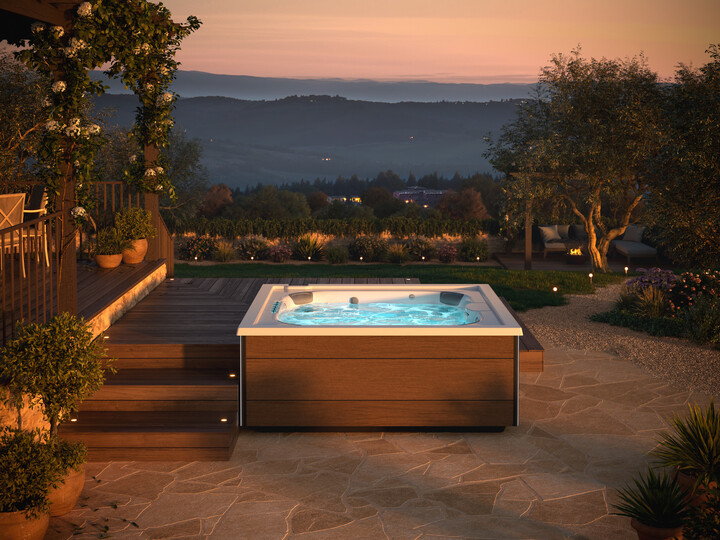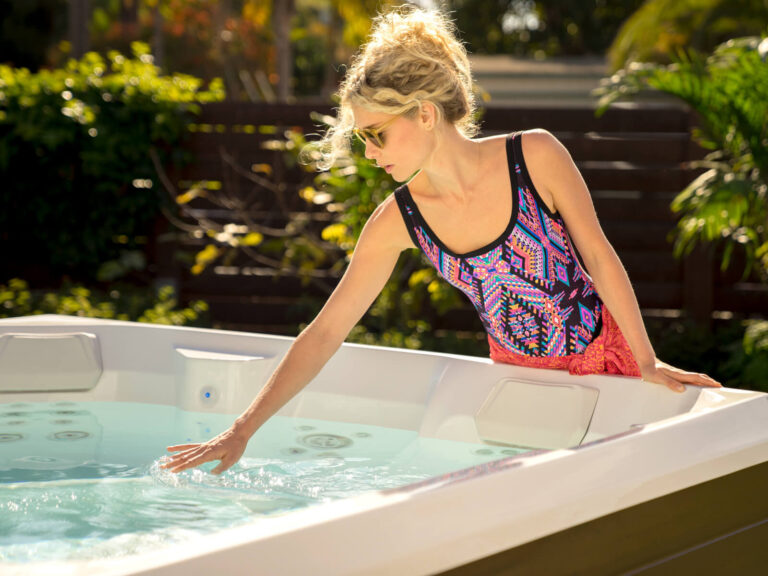Hot tub water care is a key part of owning a spa, and it goes far beyond just keeping your water clean.
In fact, without proper water care, you risk your entire spa’s quality, potentially causing damage to the shell, jets, and even your heating element.
Furthermore, improperly balanced water can result in uncomfortable experiences for you and your guests, increasing skin and eye irritation.
Whether you’re new to owning a spa and want to ensure you’re providing top-tier care, or you’ve been a long-time owner and have been struggling with water quality issues, you’ve come to the right place.
In this article, we’re going to review our top seven tips for hot tub water care, ensuring you can manage your spa like a pro for reliably clean, safe water for years to come!
Essential Water Care Products
Before we dive into the various non-negotiables when it comes to hot tub water care, let’s first cover the basic products you’re going to need to have on hand.
- Water test strips
- pH Up and pH down
- Total alkalinity increaser
- Sanitizer (chlorine or bromine)
- Filter cleaner
- Pipe cleaner
- Shell cleaner
Each of the above items will be used by every hot tub owner, but there are some that are optional, with some being required based on the quality of your initial water source. This includes items like:
- Calcium hardness increaser: To increase the hardness of soft water, making it easier to balance after a water change.
- Water softener: To reduce the hardness of your water for easier balancing.
- Defoamer: To temporarily clear up foam.
- Clarifier: A temporary solution to clear up cloudy water.
If you’re curious if you need to include a calcium hardness increaser or a water softener in your routine, getting your water source tested will help you tailor your products to your unique needs.

7 Tips for Expert Hot Tub Water Care
Now that we’ve covered your necessary water treatment products, let’s dive into the seven steps that are crucial to proper water care.
1. Test Water Regularly
First and foremost, is being aware of when your water quality changes.
The quality of your water will be influenced by three main elements: your pH, alkalinity, and sanitizer levels.
You should be testing your water at least twice a week to monitor any fluctuations and respond to them when necessary.
This will help ensure your water remains in good condition and reduces the likelihood of poorly balanced water being missed, and corrosion or scale developing.
2. Keep Alkalinity and pH Balanced
pH and alkalinity refer to the overall acidity of your water and are affected any time you add anything to the water. This can include things like other water treatment products, dirt, and even oils on your skin that contaminate the water as you soak.
While pH directly refers to how basic or acidic your water is, alkalinity determines its ability to neutralize acid, reducing the fluctuation of your pH.
The ideal levels are as follows:
- pH: Between 7.2 and 7.8
- Alkalinity: Between 80 and 120 ppm
If your pH rises above 7.8, it becomes too basic, which can result in scale forming on everything your water comes into contact with.
On the other hand, if your pH dips below 7.2, it’s become too acidic and can begin corroding various parts of your hot tub.
Using your pH up, pH down, or total alkalinity increaser, you can keep these levels balanced by carefully following the directions on their containers.
Pro Tip: Balance alkalinity first before moving on to pH levels.
3. Maintain Sanitizer Levels
Your sanitizer is responsible for keeping your water clean, killing off bacteria that have developed in your water.
There are a few different sanitizers to choose from, with many manufacturers also featuring specific systems, such as the CLEARRAY®️ system from Jacuzzi®️, to enhance water sanitization.
The two most common sanitizers are chlorine and bromine.
If you’re using chlorine, you’ll want to ensure your sanitizer levels remain between 1 and 3 ppm, while for bromine, 3 to 5 ppm is recommended.
Salt systems have also become popular over the years, generating chlorine automatically while leaving water silky smooth.
4. Clean Your Filters
Another key element in your water care is keeping your filters clean. As water circulates through your spa, your filters strip out impurities, locking even the smallest contaminants in their pleats.
This leads to a build-up of grime over time, which will need to be rinsed away to ensure they continue working effectively.
Your filter care should follow a strict schedule, including a weekly rinse, and a monthly deep clean using a spray-on, rinse-off filter cleaner.
For an even deeper clean, you can also soak your filter in diluter filter cleaner overnight.
Neglecting filter care can quickly result in a decrease in efficiency, leading to growing energy bills.
Furthermore, it can also result in poor water pressure as water has a more difficult time circulating through your system due to the clogged filters.
Here’s a quick how-to video to help get you started:
5. Drain and Deep Clean Quarterly
Even with the best of care, your water will eventually need to be refreshed, generally every three or four months.
This ensures that the TDS, or total dissolved solids, in your water don’t become too high.
Your TDS levels rise each time you add anything to your spa water, going beyond the treatment products you add and extending to the oils and contaminants you bring into the spa each time you step into the water.
A quarterly water change will ensure you’re always soaking in the cleanest water possible, while also offering the perfect time to deep clean your shell and inspect your heating element.
6. Reduce Water Contaminants
Ultimately, your water is only as clean as you allow it to be. If you’re looking for ways to reduce the treatment products needed to maintain your water quality, you’ll want to reduce the contaminants you bring into it.
Here are some easy ways to keep contaminants to a minimum:
- Rinse off before every hot tub session
- Keep hair out of the water
- Refrain from wearing lotions, cosmetics, or perfume in the spa
- Give your swimsuits an extra rinse to wash away any residual detergent
- Only use products that are designed specifically for hot tubs
- Use tennis balls or hot tub sponges after a soak to absorb any oils on the surface
Implementing these tips when using your spa can help keep your water cleaner, reducing the need for excessive sanitizer to kill bacteria.
7. Don’t Forget About Your Cover
Lastly, you’ll want to ensure you pay special attention to your cover. While it doesn’t come in direct contact with your water, the underside is consistently exposed to moisture.
If not cleaned regularly, this dampness can lead to mold or mildew developing in crevices, transferring to your shell each time you lose the cover.
Every month, take your cover off and wipe the inside with a non-abrasive cloth.
To sanitize it, you can use a 1:10 mixture of bleach and water, ensuring it’s not strong enough to damage the cover but is potent enough to kill any lingering bacteria.

Signs Your Water Requires Immediate Attention
Your water will quickly communicate to you if something is amiss, often with clear indications that are hard to miss.
If you’ve lifted your cover to discover any of these issues, you’ll want to begin troubleshooting immediately, to narrow down the root cause.
- A foul odor: This is most often caused by low sanitation, but can also be the result of clogged filters or a pH imbalance.
- A murky or cloudy: More often than not, this occurs when water is improperly balanced, but can also be from poor circulation due to clogged filters.
- A foamy surface: When water has an overload of organic matter, foam often develops on the surface, becoming quite noticeable once the jets fire up.
- Algae blooms: If sanitizer levels are too low and bacteria begin to clump together, algae blooms can begin forming.
To troubleshoot these issues, you’ll want to start by testing your water to get an accurate understanding of your water chemistry. Use the appropriate chemicals to rebalance your levels.
Giving your filters a clean at this time is also recommended, washing away any potential impurities that could end up back in your water.
If you’re unable to find the culprit of your dirty water, or it becomes a recurring issue, drain the hot tub, clean it, and refill it with fresh water.
Hot Tub Service and Maintenance in Culver, Pasadena, & More
Whether you’re struggling with persistent water quality issues or are looking for expert support in maintaining your spa, the team of professionals at Lifestyle Outdoor is here to help.
With decades of combined experience, you’ll discover a reliable and knowledgeable team of technicians ready to assist in all your spa needs.
Lifestyle Outdoor is a leader in the industry, serving the residents throughout Southern California for over 30 years, and has expanded to include five showrooms across the region.
From Ventura and Culver City to Pasadena, Sherman Oaks, and Thousand Oaks, we’re sure to have a team nearby.
Contact us today, or visit your local showroom to get started today.




